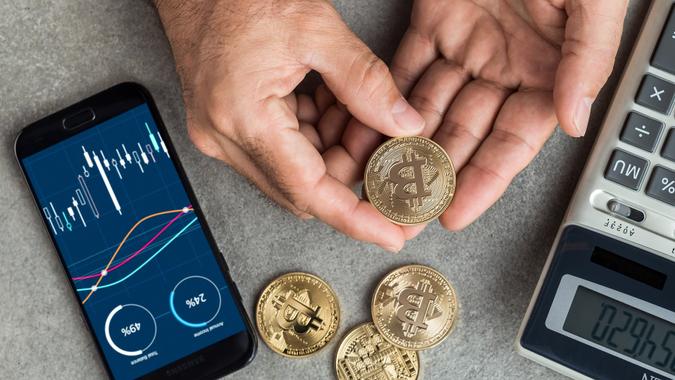Bitcoin: How Many Are There?


D-Keine / iStock.com
Bitcoin has a maximum supply of 21 million. However, that does not tell the whole story. As time goes on, it becomes increasingly difficult to acquire bitcoin due to the economics of the asset. Here’s a complete breakdown of how bitcoin works and exactly why it has a limited supply.
Read: Want to diversify in a bear market? Consider these 6 alternative investments
Bitcoin Tokenomics: Proof of Work, Mining and Halving Cycles
Tokenomics, as one might imagine, refers to the economics of a token. Similar to how fiat currencies, such as the dollar, are issued by governments and regulated through monetary policy, tokenomics refers to the rules and features surrounding cryptocurrency.
Here are all the ins and outs of bitcoin’s tokenomics, why the supply is fixed and how it works.
Why Bitcoin Uses Proof-of-Work and Mining
Bitcoin uses what is called a proof-of-work consensus mechanism. Essentially, this equates to using a lot of energy in the form of hardware to solve complex mathematical problems. This process is known as “mining” in the crypto world.
This feature not only secures the network, but it validates transactions and achieves bitcoin’s goal of removing “double spending” from existence. Double spending is the concept of counterfeiting money and the inability to distinguish real currency from counterfeit currency.
The miners contribute to the network behind the scenes by validating transactions to fulfill this gap. In exchange, the first miner to confirm all transactions on a block in the blockchain will receive a reward – approximately 6.25 bitcoins per write in 2022. However, this will change over time as a result of bitcoin’s “halving”.
How Bitcoin Halving Cycles Work
The Bitcoin halving cycle is when the rewards that miners receive for completing a block are halved. It happens once every four years.
The purpose behind halving is to limit supply and support the deflationary nature of bitcoin. As bitcoin becomes more difficult to mine, the supply decreases, corresponding to an increase in demand.
This is why bitcoin volatility usually increases every four years or so. Currently, each block reward for miners is 6.25 bitcoins, but this will drop to 3.125 bitcoins in the next cycle on March 21, 2024.
Why does Bitcoin have limited supply?
So why can there only be 21 million bitcoins? Bitcoin has a finite or limited supply to fulfill its purpose as a monetary system. Limited supply achieves the element of scarcity. The other properties of money are:
- Acceptability – use as a medium of exchange
- Durability — the ability to withstand pressure, stress or damage over time
- Divisibility — the ability to be divided into smaller and larger units
- Fungibility — the ability to exchange for goods of equal value
- Portability — easy movement and storage
Bitcoin achieves limited supply through the use of its intelligent design: a proof-of-work consensus mechanism and cryptomining.
How long would it take to mine a Bitcoin?
The simple answer is that it depends. Bitcoin mining is limited to those who can afford expensive hardware and power costs.
For example, a mining company in China mines 3% of all bitcoin. It mines 650 bitcoins monthly with an estimated electricity bill of nearly $1.2 million.
What is a Satoshi in Bitcoin?
A satoshi is the smallest denomination of bitcoin. Each bitcoin can be broken down into divisible units, not unlike the way $1 and a cent coin work. A single bitcoin consists of 100 million “satoshis” or “sats” as they are sometimes called.
Right now, one satoshi is worth approximately $0.00019. If a satoshi was ever worth $0.01, the price of a bitcoin would be $1 million.
How many Bitcoins have been mined so far?
Current data shows that 19.1 million bitcoins have been mined to date. But of that amount, it is estimated that between 3-4 million bitcoins have been lost forever.
Many people have lost their private keys or seeds that gave them access to their crypto wallets that stored bitcoin. They are now irreparable.
Others such as Satoshi Nakomoto, the creator of bitcoin, are believed to have as much as 1 million bitcoins. This anonymous person has not published any communication since 2010, and many assume that the famous character has passed away.
Do all cryptocurrencies have limited supplies?
No. Not all cryptocurrencies have a maximum issuance. Some cryptos choose to limit the number of new tokens entering circulation each year instead.
For example, some cryptocurrencies such as Ethereum have no limit to their token supply. The Ethereum network chose to cap 25% – or 19 million ETH per year – that can be produced on the blockchain.
Final Take
Bitcoin has maintained its leadership position for a reason. The governance policies and procedures surrounding the economy are what make bitcoin unique compared to most other cryptocurrencies. Its distinct procedures that follow traditional monetary systems while still remaining innovative among the pack is what sets it apart from other cryptocurrencies. Still, anyone getting involved in cryptocurrency should aim to buy it as part of a balanced portfolio of investments for diversification.
FAQ
Here are some common questions people ask about bitcoin numbers and their features.
- How many bitcoins are left?
- There are just over 1.8 million bitcoins left to mine. The last bitcoin is predicted to be mined in the year 2140. Only 21 million bitcoins will ever exist.
- How many bitcoins are mined every day?
- At today’s run rate, 900 bitcoins are mined per day.
- Is bitcoin deflationary?
- Yes. Due to bitcoin’s halving cycle every four years, miners receive fewer bitcoin rewards over time. This contributes to a halving of inflation due to the ever-decreasing supply.
The information is accurate as of 3 October 2022.
Our in-house research team and on-site financial experts work together to create content that is accurate, unbiased and up-to-date. We fact-check every single statistic, quote and fact using reliable primary sources to ensure the information we provide is correct. You can learn more about GOBankingRates’ processes and standards in our editorial guidelines.





















